Hao Huang
SGMAGNet: A Baseline Model for 3D Cloud Phase Structure Reconstruction on a New Passive Active Satellite Benchmark
Sep 19, 2025Abstract:Cloud phase profiles are critical for numerical weather prediction (NWP), as they directly affect radiative transfer and precipitation processes. In this study, we present a benchmark dataset and a baseline framework for transforming multimodal satellite observations into detailed 3D cloud phase structures, aiming toward operational cloud phase profile retrieval and future integration with NWP systems to improve cloud microphysics parameterization. The multimodal observations consist of (1) high--spatiotemporal--resolution, multi-band visible (VIS) and thermal infrared (TIR) imagery from geostationary satellites, and (2) accurate vertical cloud phase profiles from spaceborne lidar (CALIOP\slash CALIPSO) and radar (CPR\slash CloudSat). The dataset consists of synchronized image--profile pairs across diverse cloud regimes, defining a supervised learning task: given VIS/TIR patches, predict the corresponding 3D cloud phase structure. We adopt SGMAGNet as the main model and compare it with several baseline architectures, including UNet variants and SegNet, all designed to capture multi-scale spatial patterns. Model performance is evaluated using standard classification metrics, including Precision, Recall, F1-score, and IoU. The results demonstrate that SGMAGNet achieves superior performance in cloud phase reconstruction, particularly in complex multi-layer and boundary transition regions. Quantitatively, SGMAGNet attains a Precision of 0.922, Recall of 0.858, F1-score of 0.763, and an IoU of 0.617, significantly outperforming all baselines across these key metrics.
SHREC 2025: Protein surface shape retrieval including electrostatic potential
Sep 16, 2025Abstract:This SHREC 2025 track dedicated to protein surface shape retrieval involved 9 participating teams. We evaluated the performance in retrieval of 15 proposed methods on a large dataset of 11,555 protein surfaces with calculated electrostatic potential (a key molecular surface descriptor). The performance in retrieval of the proposed methods was evaluated through different metrics (Accuracy, Balanced accuracy, F1 score, Precision and Recall). The best retrieval performance was achieved by the proposed methods that used the electrostatic potential complementary to molecular surface shape. This observation was also valid for classes with limited data which highlights the importance of taking into account additional molecular surface descriptors.
* Published in Computers & Graphics, Elsevier. 59 pages, 12 figures
CurveFlow: Curvature-Guided Flow Matching for Image Generation
Aug 20, 2025Abstract:Existing rectified flow models are based on linear trajectories between data and noise distributions. This linearity enforces zero curvature, which can inadvertently force the image generation process through low-probability regions of the data manifold. A key question remains underexplored: how does the curvature of these trajectories correlate with the semantic alignment between generated images and their corresponding captions, i.e., instructional compliance? To address this, we introduce CurveFlow, a novel flow matching framework designed to learn smooth, non-linear trajectories by directly incorporating curvature guidance into the flow path. Our method features a robust curvature regularization technique that penalizes abrupt changes in the trajectory's intrinsic dynamics.Extensive experiments on MS COCO 2014 and 2017 demonstrate that CurveFlow achieves state-of-the-art performance in text-to-image generation, significantly outperforming both standard rectified flow variants and other non-linear baselines like Rectified Diffusion. The improvements are especially evident in semantic consistency metrics such as BLEU, METEOR, ROUGE, and CLAIR. This confirms that our curvature-aware modeling substantially enhances the model's ability to faithfully follow complex instructions while simultaneously maintaining high image quality. The code is made publicly available at https://github.com/Harvard-AI-and-Robotics-Lab/CurveFlow.
MapBERT: Bitwise Masked Modeling for Real-Time Semantic Mapping Generation
Jun 09, 2025Abstract:Spatial awareness is a critical capability for embodied agents, as it enables them to anticipate and reason about unobserved regions. The primary challenge arises from learning the distribution of indoor semantics, complicated by sparse, imbalanced object categories and diverse spatial scales. Existing methods struggle to robustly generate unobserved areas in real time and do not generalize well to new environments. To this end, we propose \textbf{MapBERT}, a novel framework designed to effectively model the distribution of unseen spaces. Motivated by the observation that the one-hot encoding of semantic maps aligns naturally with the binary structure of bit encoding, we, for the first time, leverage a lookup-free BitVAE to encode semantic maps into compact bitwise tokens. Building on this, a masked transformer is employed to infer missing regions and generate complete semantic maps from limited observations. To enhance object-centric reasoning, we propose an object-aware masking strategy that masks entire object categories concurrently and pairs them with learnable embeddings, capturing implicit relationships between object embeddings and spatial tokens. By learning these relationships, the model more effectively captures indoor semantic distributions crucial for practical robotic tasks. Experiments on Gibson benchmarks show that MapBERT achieves state-of-the-art semantic map generation, balancing computational efficiency with accurate reconstruction of unobserved regions.
LLM-based phoneme-to-grapheme for phoneme-based speech recognition
Jun 05, 2025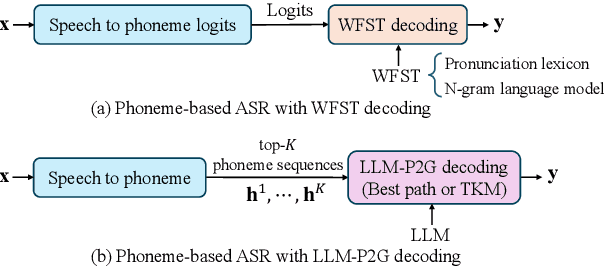

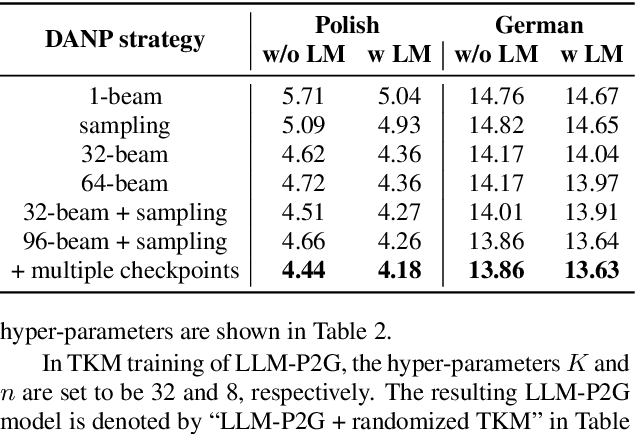

Abstract:In automatic speech recognition (ASR), phoneme-based multilingual pre-training and crosslingual fine-tuning is attractive for its high data efficiency and competitive results compared to subword-based models. However, Weighted Finite State Transducer (WFST) based decoding is limited by its complex pipeline and inability to leverage large language models (LLMs). Therefore, we propose LLM-based phoneme-to-grapheme (LLM-P2G) decoding for phoneme-based ASR, consisting of speech-to-phoneme (S2P) and phoneme-to-grapheme (P2G). A challenge is that there seems to have information loss in cascading S2P and P2G. To address this challenge, we propose two training strategies: data augmentation with noisy phonemes (DANP), and randomized top-$K$ marginalized (TKM) training and decoding. Our experimental results show that LLM-P2G outperforms WFST-based systems in crosslingual ASR for Polish and German, by relative WER reductions of 3.6% and 6.9% respectively.
Non-linear Multi-objective Optimization with Probabilistic Branch and Bound
Jun 05, 2025Abstract:A multiple objective simulation optimization algorithm named Multiple Objective Probabilistic Branch and Bound with Single Observation (MOPBnB(so)) is presented for approximating the Pareto optimal set and the associated efficient frontier for stochastic multi-objective optimization problems. MOPBnB(so) evaluates a noisy function exactly once at any solution and uses neighboring solutions to estimate the objective functions, in contrast to a variant that uses multiple replications at a solution to estimate the objective functions. A finite-time performance analysis for deterministic multi-objective problems provides a bound on the probability that MOPBnB(so) captures the Pareto optimal set. Asymptotic convergence of MOPBnB(so) on stochastic problems is derived, in that the algorithm captures the Pareto optimal set and the estimations converge to the true objective function values. Numerical results reveal that the variant with multiple replications is extremely intensive in terms of computational resources compared to MOPBnB(so). In addition, numerical results show that MOPBnB(so) outperforms a genetic algorithm NSGA-II on test problems.
H2-COMPACT: Human-Humanoid Co-Manipulation via Adaptive Contact Trajectory Policies
May 23, 2025Abstract:We present a hierarchical policy-learning framework that enables a legged humanoid to cooperatively carry extended loads with a human partner using only haptic cues for intent inference. At the upper tier, a lightweight behavior-cloning network consumes six-axis force/torque streams from dual wrist-mounted sensors and outputs whole-body planar velocity commands that capture the leader's applied forces. At the lower tier, a deep-reinforcement-learning policy, trained under randomized payloads (0-3 kg) and friction conditions in Isaac Gym and validated in MuJoCo and on a real Unitree G1, maps these high-level twists to stable, under-load joint trajectories. By decoupling intent interpretation (force -> velocity) from legged locomotion (velocity -> joints), our method combines intuitive responsiveness to human inputs with robust, load-adaptive walking. We collect training data without motion-capture or markers, only synchronized RGB video and F/T readings, employing SAM2 and WHAM to extract 3D human pose and velocity. In real-world trials, our humanoid achieves cooperative carry-and-move performance (completion time, trajectory deviation, velocity synchrony, and follower-force) on par with a blindfolded human-follower baseline. This work is the first to demonstrate learned haptic guidance fused with full-body legged control for fluid human-humanoid co-manipulation. Code and videos are available on the H2-COMPACT website.
RAIL: Region-Aware Instructive Learning for Semi-Supervised Tooth Segmentation in CBCT
May 06, 2025Abstract:Semi-supervised learning has become a compelling approach for 3D tooth segmentation from CBCT scans, where labeled data is minimal. However, existing methods still face two persistent challenges: limited corrective supervision in structurally ambiguous or mislabeled regions during supervised training and performance degradation caused by unreliable pseudo-labels on unlabeled data. To address these problems, we propose Region-Aware Instructive Learning (RAIL), a dual-group dual-student, semi-supervised framework. Each group contains two student models guided by a shared teacher network. By alternating training between the two groups, RAIL promotes intergroup knowledge transfer and collaborative region-aware instruction while reducing overfitting to the characteristics of any single model. Specifically, RAIL introduces two instructive mechanisms. Disagreement-Focused Supervision (DFS) Controller improves supervised learning by instructing predictions only within areas where student outputs diverge from both ground truth and the best student, thereby concentrating supervision on structurally ambiguous or mislabeled areas. In the unsupervised phase, Confidence-Aware Learning (CAL) Modulator reinforces agreement in regions with high model certainty while reducing the effect of low-confidence predictions during training. This helps prevent our model from learning unstable patterns and improves the overall reliability of pseudo-labels. Extensive experiments on four CBCT tooth segmentation datasets show that RAIL surpasses state-of-the-art methods under limited annotation. Our code will be available at https://github.com/Tournesol-Saturday/RAIL.
Multi-segment Soft Robot Control via Deep Koopman-based Model Predictive Control
May 01, 2025Abstract:Soft robots, compared to regular rigid robots, as their multiple segments with soft materials bring flexibility and compliance, have the advantages of safe interaction and dexterous operation in the environment. However, due to its characteristics of high dimensional, nonlinearity, time-varying nature, and infinite degree of freedom, it has been challenges in achieving precise and dynamic control such as trajectory tracking and position reaching. To address these challenges, we propose a framework of Deep Koopman-based Model Predictive Control (DK-MPC) for handling multi-segment soft robots. We first employ a deep learning approach with sampling data to approximate the Koopman operator, which therefore linearizes the high-dimensional nonlinear dynamics of the soft robots into a finite-dimensional linear representation. Secondly, this linearized model is utilized within a model predictive control framework to compute optimal control inputs that minimize the tracking error between the desired and actual state trajectories. The real-world experiments on the soft robot "Chordata" demonstrate that DK-MPC could achieve high-precision control, showing the potential of DK-MPC for future applications to soft robots.
Embodied Chain of Action Reasoning with Multi-Modal Foundation Model for Humanoid Loco-manipulation
Apr 13, 2025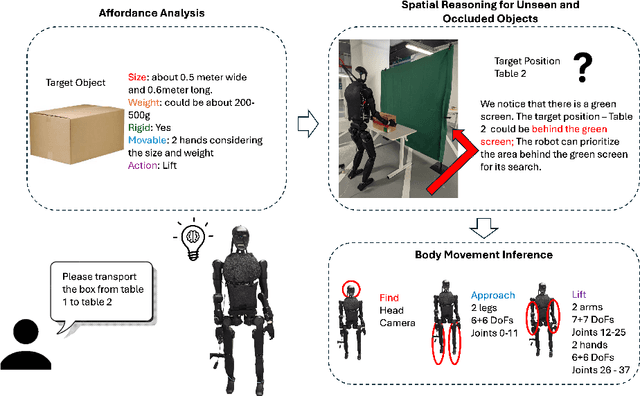
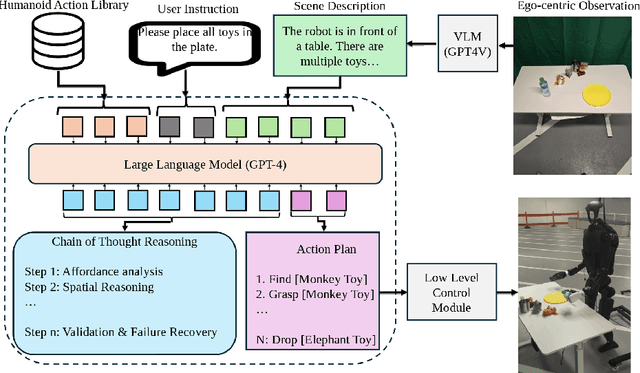
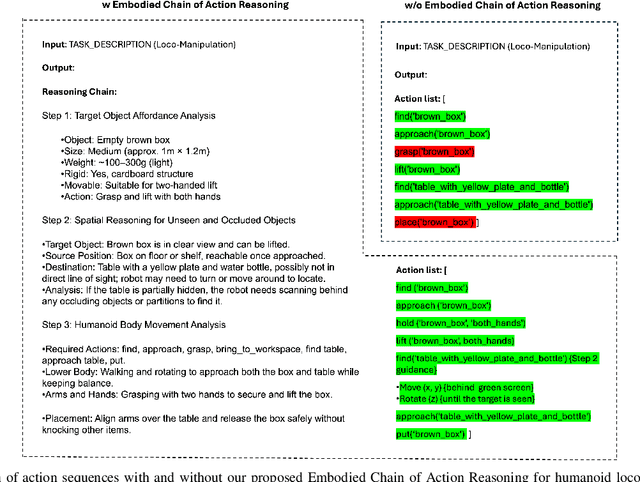
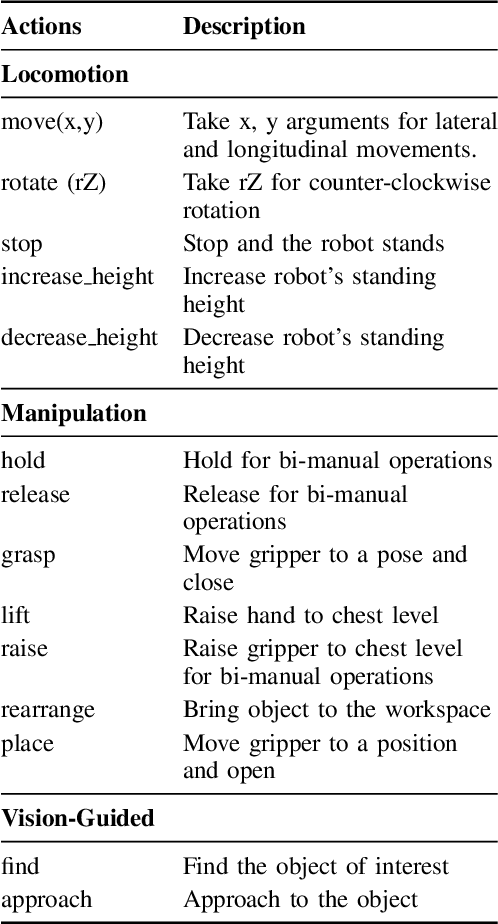
Abstract:Enabling humanoid robots to autonomously perform loco-manipulation tasks in complex, unstructured environments poses significant challenges. This entails equipping robots with the capability to plan actions over extended horizons while leveraging multi-modality to bridge gaps between high-level planning and actual task execution. Recent advancements in multi-modal foundation models have showcased substantial potential in enhancing planning and reasoning abilities, particularly in the comprehension and processing of semantic information for robotic control tasks. In this paper, we introduce a novel framework based on foundation models that applies the embodied chain of action reasoning methodology to autonomously plan actions from textual instructions for humanoid loco-manipulation. Our method integrates humanoid-specific chain of thought methodology, including detailed affordance and body movement analysis, which provides a breakdown of the task into a sequence of locomotion and manipulation actions. Moreover, we incorporate spatial reasoning based on the observation and target object properties to effectively navigate where target position may be unseen or occluded. Through rigorous experimental setups on object rearrangement, manipulations and loco-manipulation tasks on a real-world environment, we evaluate our method's efficacy on the decoupled upper and lower body control and demonstrate the effectiveness of the chain of robotic action reasoning strategies in comprehending human instructions.
 Add to Chrome
Add to Chrome Add to Firefox
Add to Firefox Add to Edge
Add to Edge